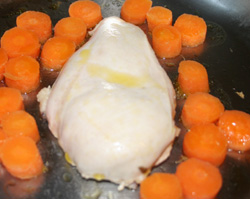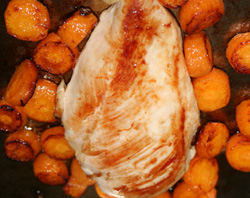What is the Maillard Reaction?


Image Left: Chicken breast with carrots cooked at 200F, Image Right: Chicken breast with carrots cooked above 300F
Browning, or the Maillard reaction, creates flavor and changes the color of food. Maillard reactions generally only begin to occur above 285°F (140°C). Until the Maillard reaction occurs meat will have less flavor. Shown above are two identical dishes cooked (left) below (140°C) and right at much higher temperatures. Both caramelization and the maillard reaction only occur on the right producing the noticeable brown color.
The Maillard reaction is a chemical reaction between an amino acid and a reducing sugar, usually requiring the addition of heat. Like caramelization, it is a form of non-enzymatic browning. The reactive carbonyl group of the sugar interacts with the nucleophilic amino group of the amino acid, and interesting but poorly characterized odor and flavor molecules result. This process accelerates in an alkaline environment because the amino groups do not neutralize. This reaction is the basis of the flavoring industry, since the type of amino acid determines the resulting flavor.
In the process, hundreds of different flavor compounds are created. These compounds in turn break down to form yet more new flavor compounds, and so on. Each type of food has a very distinctive set of flavor compounds that are formed during the Maillard reaction. It is these same compounds that flavor scientists have used over the years to create artificial flavors.
The Maillard reaction should not be confused with Caramelization which occurs with sugars.
Although used since ancient times, the reaction is named after the chemist Louis-Camille Maillard who investigated it in the 1910s.
Products with Maillard reactions
The Maillard reaction is responsible for many colors and flavors in foodstuffs:
- caramel made from milk and sugar
- the browning of bread into toast
- the color of beer, chocolate, coffee, and maple syrup
- self-tanning products
- the flavor of roast meat
- the color of dried or condensed milk
6-acetyl-1,2,3,4-tetrahydropyridine (1) is responsible for the biscuit or cracker-like odor present in baked goods like bread, popcorn, tortilla products. The structurally related compound 2-acetyl-1-pyrroline has a similar smell, and also occurs naturally without heating and gives varieties of cooked rice their aroma. Both compounds have odor thresholds below 0.06 ng/l [1].
The process
- The carbonyl group of the sugar reacts with the amino group of the amino acid, producing N-substituted glycosylamine and water
- The unstable glycosylamine undergoes Amadori rearrangement, forming ketosamines
- There are several ways for the ketosamines to react further:
- Produce 2 water and reductones
- Diacetyl, aspirin, pyruvaldehyde and other short-chain hydrolytic fission products can be formed
- Produce brown nitrogenous polymers and melanoidins
Key Factors
Pentose sugars react more than hexoses, which react more than disaccharides.
Different amino acids produce different amounts of browning.
Since the Maillard reaction produces water, having a high water activity environment inhibits the reaction.
See also:
What are the effects of cooking on the Maillard Reaction
Why red meat turns brown when vacuum sealed.
Important temperatures in cooking
External links
References
- An Expeditious, High-Yielding Construction of the Food Aroma Compounds 6-Acetyl-1,2,3,4-tetrahydropyridine and 2-Acetyl-1-pyrroline Tyler J. Harrison and Gregory R. Dake J. Org. Chem.; 2005; 70(26) pp 10872 - 10874; (Note) DOI: 10.1021/jo051940a Abstract
- Nahid Tamanna , and Niaz Mahmood. (2015) Food Processing and Maillard Reaction Products: Effect on Human Health and Nutrition. Int J Food Sci. 2015; 2015: 526762.